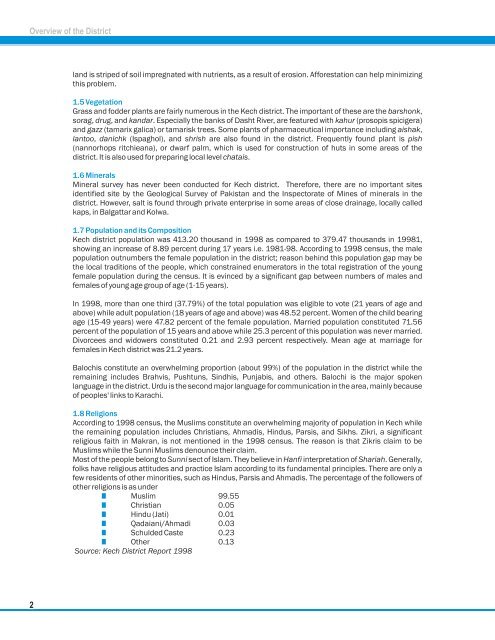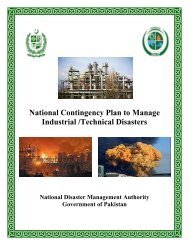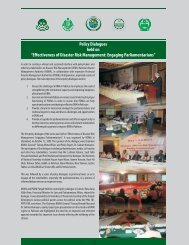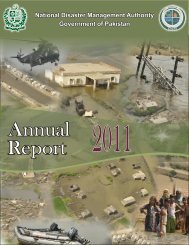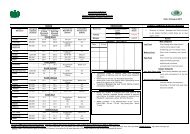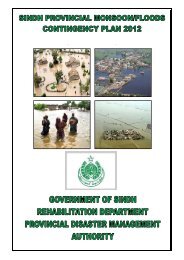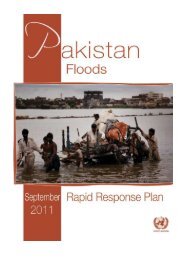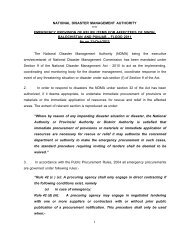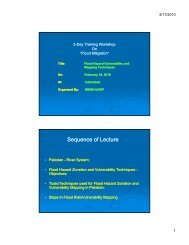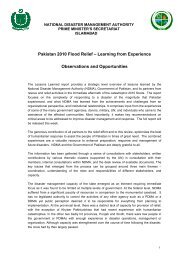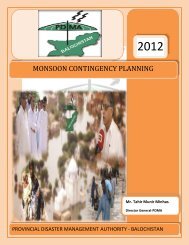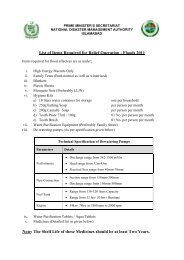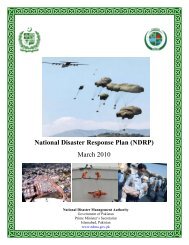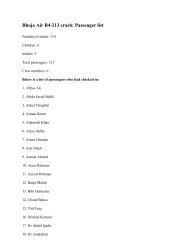District Disaster Management Plan District Kech, Balochistan - NDMA
District Disaster Management Plan District Kech, Balochistan - NDMA
District Disaster Management Plan District Kech, Balochistan - NDMA
You also want an ePaper? Increase the reach of your titles
YUMPU automatically turns print PDFs into web optimized ePapers that Google loves.
Overview of the <strong>District</strong><br />
land is striped of soil impregnated with nutrients, as a result of erosion. Afforestation can help minimizing<br />
this problem.<br />
1.5 Vegetation<br />
Grass and fodder plants are fairly numerous in the <strong>Kech</strong> district. The important of these are the barshonk,<br />
sorag, drug, and kandar. Especially the banks of Dasht River, are featured with kahur (prosopis spicigera)<br />
and gazz (tamarix galica) or tamarisk trees. Some plants of pharmaceutical importance including aishak,<br />
lantoo, danichk (Ispaghol), and shrish are also found in the district. Frequently found plant is pish<br />
(nannorhops ritchieana), or dwarf palm, which is used for construction of huts in some areas of the<br />
district. It is also used for preparing local level chatais.<br />
1.6 Minerals<br />
Mineral survey has never been conducted for <strong>Kech</strong> district. Therefore, there are no important sites<br />
identified site by the Geological Survey of Pakistan and the Inspectorate of Mines of minerals in the<br />
district. However, salt is found through private enterprise in some areas of close drainage, locally called<br />
kaps, in Balgattar and Kolwa.<br />
1.7 Population and its Composition<br />
<strong>Kech</strong> district population was 413.20 thousand in 1998 as compared to 379.47 thousands in 19981,<br />
showing an increase of 8.89 percent during 17 years i.e. 1981-98. According to 1998 census, the male<br />
population outnumbers the female population in the district; reason behind this population gap may be<br />
the local traditions of the people, which constrained enumerators in the total registration of the young<br />
female population during the census. It is evinced by a significant gap between numbers of males and<br />
females of young age group of age (1-15 years).<br />
In 1998, more than one third (37.79%) of the total population was eligible to vote (21 years of age and<br />
above) while adult population (18 years of age and above) was 48.52 percent. Women of the child bearing<br />
age (15-49 years) were 47.82 percent of the female population. Married population constituted 71.56<br />
percent of the population of 15 years and above while 25.3 percent of this population was never married.<br />
Divorcees and widowers constituted 0.21 and 2.93 percent respectively. Mean age at marriage for<br />
females in <strong>Kech</strong> district was 21.2 years.<br />
Balochis constitute an overwhelming proportion (about 99%) of the population in the district while the<br />
remaining includes Brahvis, Pushtuns, Sindhis, Punjabis, and others. Balochi is the major spoken<br />
language in the district. Urdu is the second major language for communication in the area, mainly because<br />
of peoples' links to Karachi.<br />
1.8 Religions<br />
According to 1998 census, the Muslims constitute an overwhelming majority of population in <strong>Kech</strong> while<br />
the remaining population includes Christians, Ahmadis, Hindus, Parsis, and Sikhs. Zikri, a significant<br />
religious faith in Makran, is not mentioned in the 1998 census. The reason is that Zikris claim to be<br />
Muslims while the Sunni Muslims denounce their claim.<br />
Most of the people belong to Sunni sect of Islam. They believe in Hanfi interpretation of Shariah. Generally,<br />
folks have religious attitudes and practice Islam according to its fundamental principles. There are only a<br />
few residents of other minorities, such as Hindus, Parsis and Ahmadis. The percentage of the followers of<br />
other religions is as under<br />
Muslim 99.55<br />
Christian 0.05<br />
Hindu (Jati) 0.01<br />
Qadaiani/Ahmadi 0.03<br />
Schulded Caste 0.23<br />
Other 0.13<br />
Source: <strong>Kech</strong> <strong>District</strong> Report 1998<br />
2


